
The United States Range is one of the northernmost mountain ranges of the Arctic Cordillera and in the world, surpassed only by the Challenger Mountains to the northwest. The range is located in the northeastern region of Ellesmere Island in Nunavut, Canada, and is part of the Innuitian Mountains. The highest mountain in the range is Mount Eugene with an elevation of 1,860 metres (6,100 ft). The British Empire Range is immediately to the west of the United States Range.

Larvaceans or appendicularians, class Appendicularia, are solitary, free-swimming tunicates found throughout the world's oceans. While larvaceans are filter feeders like most other tunicates, they keep their tadpole-like shape as adults, with the notochord running through the tail. They can be found in the pelagic zone, specifically in the photic zone, or sometimes deeper. They are transparent planktonic animals, usually ranging from 2 mm (0.079 in) to 8 mm (0.31 in) in body length including the tail, although giant larvaceans can reach up to 10 cm (3.9 in) in length.
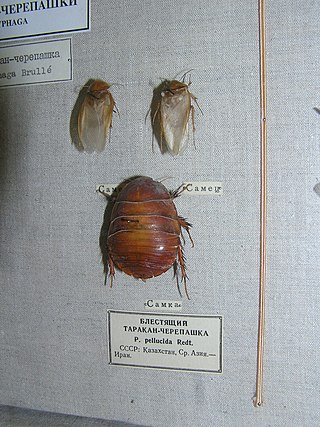
Corydiidae, previously known as Polyphagidae, is a family of the order Blattodea (cockroaches). Many are known as sand cockroaches. The family is divided into five subfamilies, comprising some 40 genera. One prominent species is the desert cockroach, Arenivaga investigata.
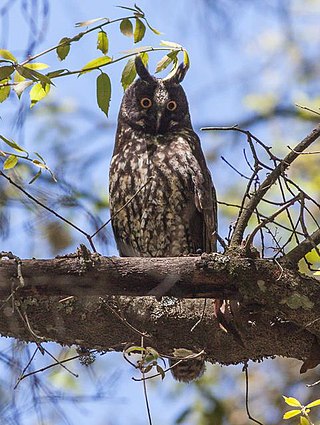
The Stygian owl is a medium-sized "typical owl" in subfamily Striginae. It is found in Mexico, parts of Central America, Cuba, Hispaniola, and 10 countries in South America.
Amatorculus stygius is a species of jumping spider in the family Salticidae. It is found in Brazil.
Stygian refers to the goddess and underworld river Styx in Greek mythology.
Comaldessus stygius is a species of beetles in the family Dytiscidae, the only species in the genus Comaldessus.
Orthogonius stygius is a species of ground beetle in the subfamily Orthogoniinae. It was described by Andrewes in 1930.

Grandma Lake Wetlands State Natural Area is a Wisconsin Department of Natural Resources-designated State Natural Area featuring the undeveloped, pristine 44-acre Grandma Lake, which lies in a depression formed during the last glacial period. The lake is ringed by a large, open sphagnum bog mat. The bog mat is surrounded by a coniferous swamp of tamarack and black spruce. The bog mat supports a plant community that is considered diverse and unusual, with several rare species present, including: bog arrow-grass, dragon's mouth orchid, livid sedge, small-headed bog sedge, as well as one of only a few known populations of bog rush in the State of Wisconsin. In 1991, the US Forest Service designated the site as a Research Natural Area. Also, the site is listed as one of Wisconsin's Wetland Gems, by the Wisconsin Wetlands Association.

Black Tern Bog State Natural Area is a Wisconsin Department of Natural Resources-designated State Natural Area featuring 20 acres of quaking sphagnum bog surrounding two small seepage lakes situated in a pitted outwash plain. The bog is rich in plant species, such as sundews, pitcher plant, bogbean, and bog rosemary, as well as three species of bog orchids: swamp pink, grass pink, and rose pogonia. The state-endangered bog rush also grows here. Birds known to nest here include black tern, American bittern, killdeer, and mallards.
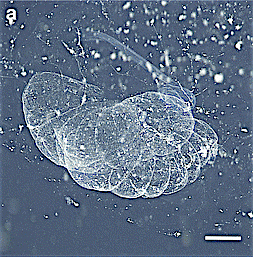
Bathochordaeus charon is a species of giant larvacean, a solitary, free-swimming tunicate that filter feeds in surface waters. The species was named after Charon, the mythical Greek ferryman who carried the souls of the dead across the rivers dividing the world of the living from the world of the dead.

Bathochordaeus, the giant larvaceans, is a genus of larvacean tunicates in the family Oikopleuridae. They are free-swimming filter-feeding marine animals that build mucus bubbles. They eat tiny particles of dead or drifting organic material that float through the water column, which contribute to the oceanic carbon cycle and the accelerated transfer of carbon to the deep sea.
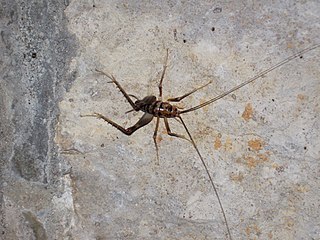
Ceuthophilus stygius, known generally as the Kentucky cave cricket or cave camel cricket, is a species of camel cricket in the family Rhaphidophoridae. It is found in North America.
Bucolion stygius is a species of cockroach found in South America. It is the sole species in the genus Bucolion.
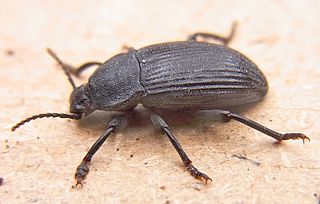
Dendarus is a genus of darkling beetles in the family Tenebrionidae. The genus is distributed from Morocco to Caucasus and exhibits a high level of diversity with 36 species, 27 of which are island endemics. Analyses of the phylogenetic relationships of 23 species from Greece and Turkey revealed 13 distinct lineages with several para- and polyphyletic cases corresponding to three major phylogroups [south/south-east Aegean ; central to north Aegean, Turkey and mainland Greece and mainland Greece ].
Phreatobacter stygius is a Gram-negative, aerobic and motile bacterium from the genus of Phreatobacter.
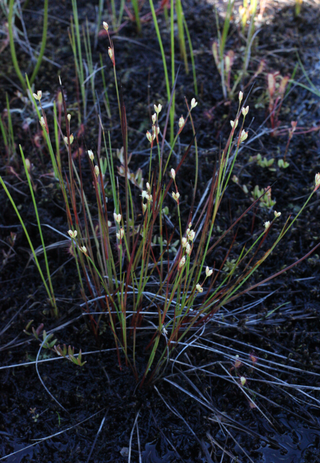
Juncus stygius, called the bog rush and moor rush, is a species of flowering plant in the genus Juncus, with a high circumboreal distribution, never reaching further south than Switzerland, Korea and Upstate New York.
Bathochordaeus mcnutti, the blue-tailed giant larvacean, is a species of larvacean in the genus Bathochordaeus within the family Oikopleuridae. It's found in the North Pacific Ocean, it is comparatively large and reaching up to 10 centimeters in length including the tail. It can be distinguished from other giant larvaceans by its bright blue tail margin.
Atractus stygius is a species of snake in the family Colubridae. The species can be found in Brazil.
Mesochordaeus is a genus of oikopleurid larvacean, related to Bathochordaeus.










